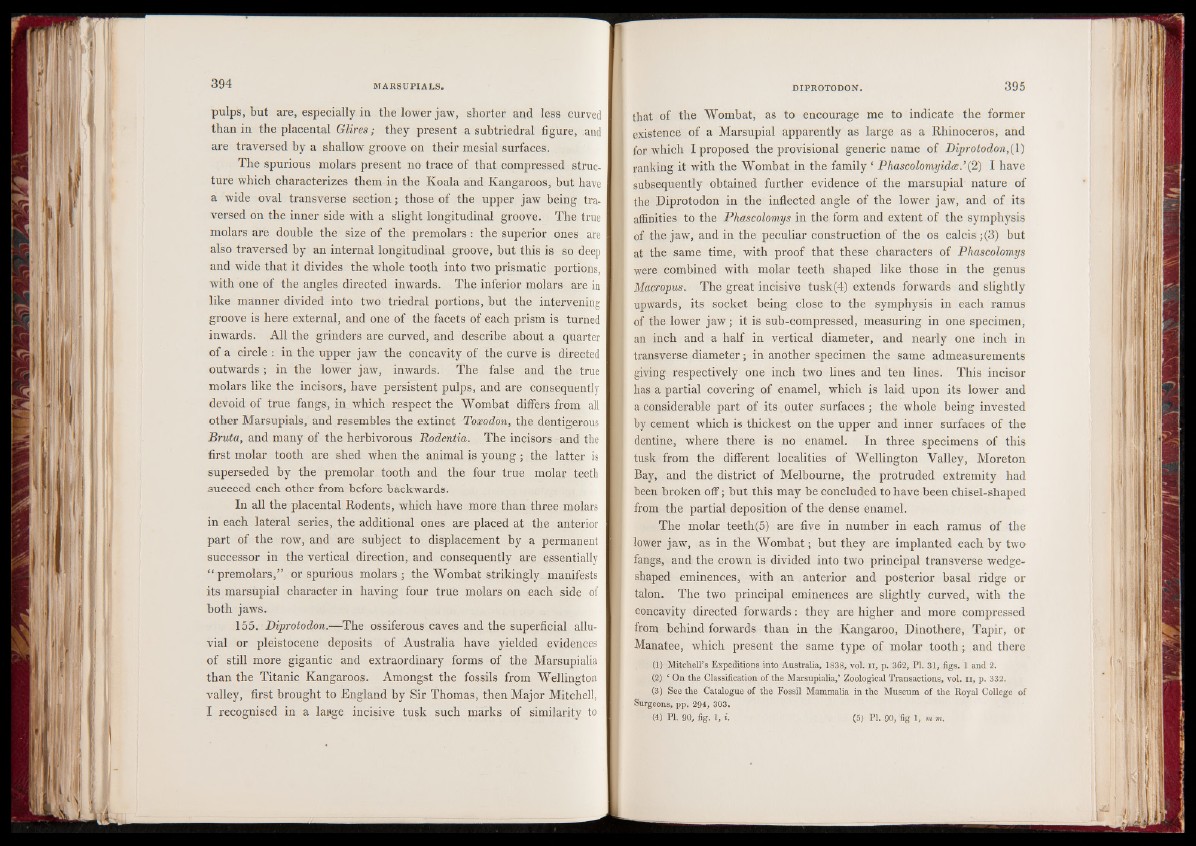
pulps, but are, especially in the lower jaw, shorter and less curved
than in the placental Glires; they present a subtriedral figure, .and
are traversed by a shallow groove on their mesial surfaces.
The spurious molars present no trace of that compressed structure
which characterizes them in the Koala and Kangaroos, hut have
a wide oval transverse section; those of the upper jaw being traversed
on the inner side with a slight longitudinal groove. The true
molars are double the size of the premolars: the superior ones are
also traversed by an internal longitudinal groove, but this is so deep
and wide that it divides the whole tooth into two prismatic portions,
with one of the angles directed inwards. The inferior molars are in
like manner divided into two triedral portions, but the intervening
groove is here external, and one of the facets of each prism is turned
inwards. All the grinders are curved, and describe about a quarter
of a circle : in the upper jaw the concavity of the curve is directed
outwards; in the lower jaw, inwards. The false and the true
molars like the incisors, have persistent pulps, and are consequently
devoid of true fangs, in which respect the Wombat differs from all
other Marsupials, and resembles the extinct Toxodon, the dentigerous
Bruta, and many of the herbivorous Rodentia. The incisors and the
first molar tooth are shed when the animal is young; the latter is
superseded by the premolar tooth and the four true molar teeth
succeed each other from before backwards.
In all the placental Rodents, which have more than three molars
in each lateral series, the additional ones are placed at the anterior
part of the row, and are subject to displacement by a permanent
successor in the vertical direction, and consequently are essentially
“ premolars,” or spurious molars; the Wombat strikingly manifests
its marsupial character in having four true molars on each side of
both jaws.
155. Diprotodon.—The ossiferous caves and the superficial alluvial
or pleistocene deposits of Australia have yielded evidences
of still more gigantic and extraordinary forms of the Marsupialia
than the Titanic Kangaroos. Amongst the fossils from Wellington
valley, first brought to England by Sir Thomas, then Major Mitchell,
I recognised in a lange incisive tusk such marks of similarity to
that of the Wombat, as to encourage me to indicate the former
existence of a Marsupial apparently as large as a Rhinoceros, and
for which I proposed the provisional generic name of Diprotodon,{1)
ranking it with the Wombat in the family f Phascolomyidce(2) I have
subsequently obtained further evidence of the marsupial nature of
the Diprotodon in the inflected angle of the lower jaw, and of its
affinities to the Phascolomys in the form and extent of the symphysis
of the jaw, and in the peculiar construction of the os calcis ;(3) but
at the same time, with proof that these characters of Phascolomys
were combined with molar teeth shaped like those in the genus
Macropus. The great incisive tusk(4) extends forwards and slightly
upwards, its socket being close to the symphysis in each ramus
of the lower jaw; it is sub-compressed, measuring in one specimen,
an inch and a half in vertical diameter, and nearly one inch in
transverse diameter; in another specimen the same admeasurements
giving respectively one inch two lines and ten lines. This incisor
has a partial covering of enamel, which is laid upon its lower and
a considerable part of its outer surfaces ; the whole being invested
by cement which is thickest on the upper and inner surfaces of the
dentine, where there is no enamel. In three specimens of this
tusk from the different localities of Wellington Valley, Moreton
Bay, and the district of Melbourne, the protruded extremity had
been broken off; but this may be concluded to have been chisel-shaped
from the partial deposition of the dense enamel.
The molar teeth(5) are five in number in each ramus of the
lower jaw, as in the Wombat; but they are implanted each by two
fangs, and the crown is divided into two principal transverse wedge-
shaped eminences, with an anterior and posterior basal ridge or
talon. The two principal eminences are slightly curved, with the
concavity directed forwards: they are higher and more compressed
from behind forwards than in the Kangaroo, Dinothere, Tapir, or
Manatee, which present the same type of molar tooth; and there
(1) Mitchell’s Expeditions into Australia, 1838, vol. n, p. 362, PI. 31, figs. 1 and 2.
(2) * On the Classification of the Marsupialia,’ Zoological Transactions, vol. n, p. 332.
(3) See the Catalogue of the Fossil Mammalia in the Museum of the Royal College of
Surgeons, pp. 294, 303.
!|| PI. 90, fig. 1, I